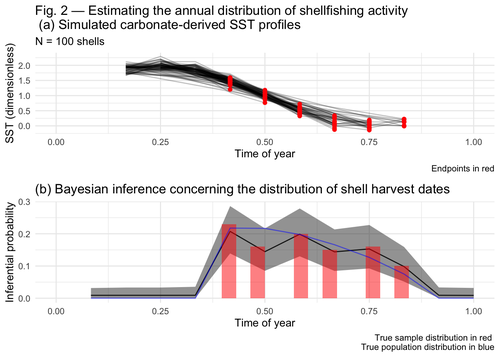


The paper by Brown & Lewis [1] presents an approach to measure seasonal mobility and subsistence practices. In order to do so, the paper proposes a Bayesian mixture model to estimate the annual distribution of shellfish harvesting activity. Following the recommendations of the two reviewers, the paper presents a clear and innovative method to assess seasonal mobility for prehistoric groups, although it could benefit from additional references regarding isotopic literature.
While the adequacy of isotope analysis for estimating mobility patterns in Archaeology has been extensively proven by now, work on specific seasonal mobility is not that much abundant. However, this is a key issue, since seasonal mobility is one of the main social components defining the differences between groups both considering farming vs hunting and gathering or even among hunter-gatherer groups themselves. In this regard, the paper brings a valuable methodological resources that can be used for further research in this issue.
One of its greatest values is the fact that it can quantify the uncertainty present in previous isotope studies in seasonal mobility. As stated by the authors, the model can still undergo several optimisation aspects, but as it stands, it is already providing a valuable asset regarding the quantification of uncertainy in the isotopic studies of seasonal mobility.
Reference
[1] Brown, J. and Lewis, G. (2024). Inferring shellfishing seasonality from the isotopic composition of biogenic carbonate: A Bayesian approach. Zenodo, 7949547, ver. 3 peer-reviewed and recommended by Peer Community in Archaeology. https://doi.org/10.5281/zenodo.7949547
As I am more focussed on isotope analysis in archaeological research, I would suggest you elaborate a bit on the potential integration of the method in your paper. Please go through the respective literature (there is plenty) and provide some basic introduction and knowledge of what your paper actually aims at. I am convinced that the paper will gain in strength or actual significance after careful consideration of what has been done in the last years and acknowledge the work of all the colleagues out there.
https://doi.org/10.24072/pci.archaeo.100419.rev11
The manuscript "Inferring Shellfishing Seasonality from the Isotopic Composition of Biogenic Carbonate: A Bayesian Approach" presents a comprehensive statistical framework for analyzing seasonality based on isotope data. This is an excellent paper that requires no further corrections.
Novelty of the approach: The manuscript represents a significant step in the formalization of seasonality analysis, which until now, as mentioned by the authors, involves several unstandardized, qualitative steps, such as eyeballing arbitrary "seasons" from SST curves. Secondly, the focus on uncertainty quantification is notable and very much welcome. Altogether, the approach presented is a step in the right direction.
Relevance: While I'm not in a position to fully assess the relevance of this paper to the community of bioarchaeologists, based on the paper's claims, the presented method is of high relevance and has a high potential to substantially impact current archaeological practice. It falls within the scope of the CAA proceedings.
The method: The method is very well described and argued. I see no errors of logic or obvious omissions. I'd urge the authors to proceed with carefully designed validation studies since once an automated pipeline is adapted into standard practice, it is common to depend on such a tool rather uncritically. This consideration is, however, outside the scope of this manuscript. Please note, I have not done a detailed review of the R scripts.
Language and presentation: The presentation of the manuscript is outstanding. It is very well structured and well written. The structure of the paper, in particular, is exemplary (I'm thinking of using it to teach my students what the standard components of a scientific paper are). Figures are clear and informative, although their captions could be a bit more descriptive. One comment I have is that the language used is rather far on the "scientific style," characterized by heavy use of passive voice, noun constructions replacing verbs (e.g., "theoretical defensibility" instead of "is not defensible..."), and heavy reliance on specialist lingo and less common words. This makes it harder for students or those entering into the topic, or any non-English speakers to quickly grasp what is being said. It is obviously fine to use this widely accepted across academia style, and I leave it as a comment rather than criticism. Having said that, the description of the method is fantastically clear and well-explained, so I'm only suggesting to, in the future, perhaps consider mellowing the style a bit in the introduction and discussion sections.
https://doi.org/10.24072/pci.archaeo.100419.rev12